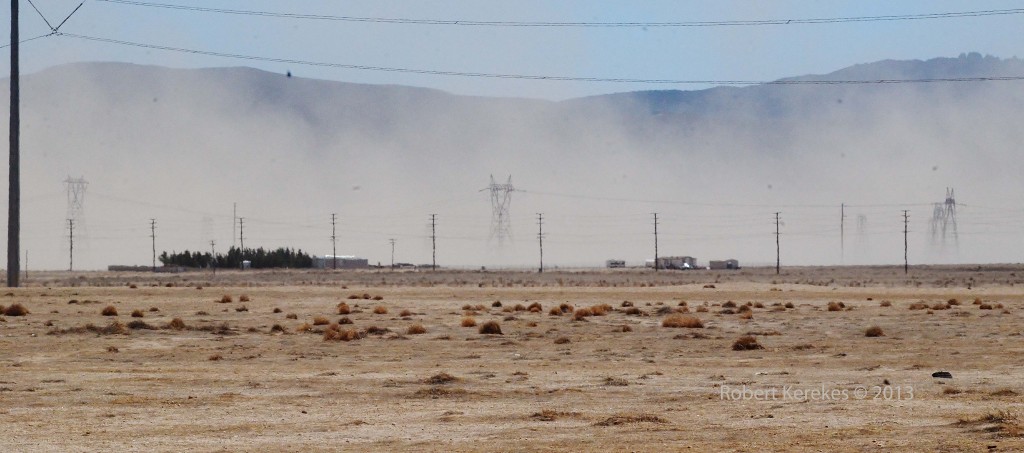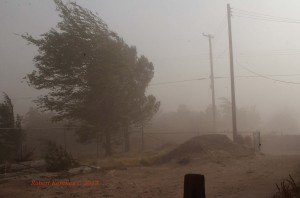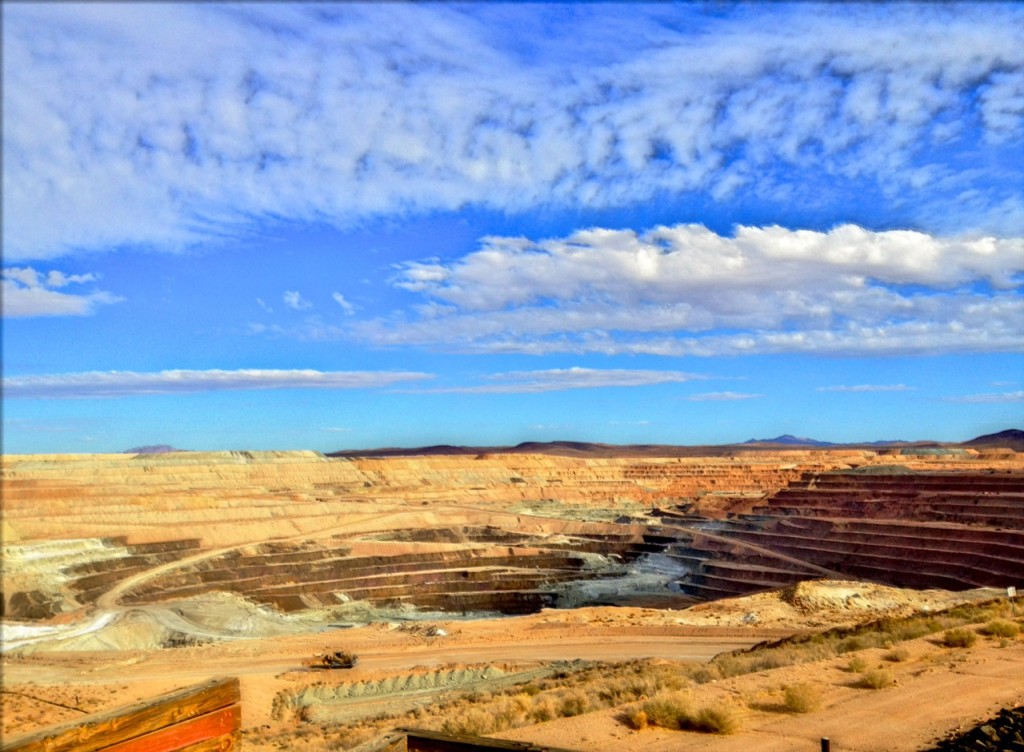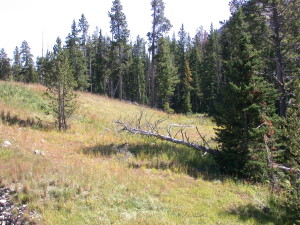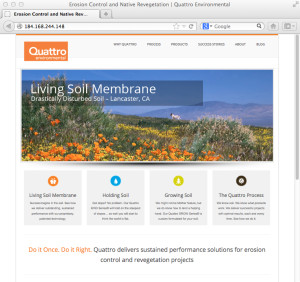03 Nov 2014
Interstellar Erosion
The movie “Interstellar”, coming to theaters this November, is about astronauts who take to the cosmos to find a new place to live because – guess why — the earth is dying from a scourge that wipes out crops and turns the planet into “one great dust bowl” (Time magazine, November 10, 2014, page 46). Time to get to work, erosion control professionals! We CAN save the planet, which is much easier than trying to find a new one to live on.
To prevent dust bowls, preserve the topsoil in the short term with BIND | ATLAS SUPERDUTY. For long term results, stabilize top soil with Quattro’s Living Soil Membrane, which re-establishes a functioning soil community for sustainable native plant growth.
Of course, then we wouldn’t have a blockbuster movie premise…….
24 Sep 2014
S.O.S – 250 Facebook Votes to Save Our Soil
Please vote for Quattro Environmental, Inc. at www.missionmainstreetgrants.com/business/detail/17089.
Quattro has the technologies to mitigate one of the greatest threats to our society: ecological suicide via erosion, soil salinization, and soil fertility losses. What Quattro lacks is the manpower to get the word out. Winning the Mission Main Street Grant would help us “blanket the earth” with our technologies.
Eighteen years ago I was at an International Erosion Control Association conference when a startling consensus was announced: The low bid mandate for awarding state agency native plant seeding contracts was the most expensive route to implementing a revegetation project!
Fast forward to 2014, there have been no significant changes made to our dysfunctional government policies, and taxpayer funds continue to be squandered on revegetation efforts that have little chance of being successful. Until now.
In what Peter Thiel might call a “vertical progress” idea, Quattro announced their Certified Reclamation Team in May 2014, designed to overcome the tried-and-failed design and implementation shortcomings of State and Federal agency reclamation efforts. Now we can provide government agencies the same enhanced reclamation success as is enjoyed by private sector companies such as Shell Oil, Hyundai Motor Corporation, Rio Tinto Minerals, Central AZ Project and others. An outline of the program can be viewed at https://www.quattroenvironmental.com/2014/05/
When we are successful at accumulating 250 votes for Quattro’s application for a Mission Main Street Grant, we become eligible for a $150,000 grant to more effectively tell our Quattro “Living Soil Membrane” technology story. Your vote in favor of Quattro Environmental, Inc. would be appreciated in making this a reality.
Note: You must have a Facebook account to place your vote at the URL listed above. Alternatively, you can:
- Go to www.missionmainstreetgrants.com
- Search for Quattro Environmental, Inc.
- Click the VOTE NOW button next to the business name.
Thanks.
BACKGROUND:
During the 2014 March through May windy season, fugitive dust in the Western Antelope Valley (located in northern Los Angeles County and the southeast portion of Kern County, California) negatively impacted air quality to an extent never experienced before. It has been likened to the Great Dust Bowl of the 1930‘s.
The historic drought of the past six years is generally acknowledged as precipitating the clouds of sand, which become airborne with the strong dry winds blowing in the afternoon and evening. However, the much hoped-for end to the drought (if we do indeed get El Nino conditions this winter) will not solve the Mojave* Dust Bowl problem.
The sources of this dust are complex: Large scale solar and wind power facilities, and Southern California Edison’s grid line and power station infrastructure are the current suspected causes of the problem. However, anyone who delves into the history of this high desert land soon realizes that the combination of barren or abandoned farm land is also a major contributing culprit. Solar farms, power corridors and urban development have undoubtedly contributed to dust emanating from large tracts of disturbed lands during construction activities, but similarly vulnerable bare agricultural lands (land being tilled; fallow fields; post-harvest fields) are in all likelihood the greatest contributor to poor air quality.

Solar power development prior to re-establishment of sustainable native plant growth for long-term soil stabilization.
In addition to on-going large-scale cropping activities, historic disturbances included the introduction of exotic grasses for cattle grazing in place of native plant species over extensive tracts of desert lands, which has made these lands especially susceptible to wind erosion during drought conditions.
THE PROBLEM:
Problems created by fugitive dust include:
- soil erosion, especially topsoil loss;
- dune formation, including the burial of buildings, fences etc.;
- poor visibility, periodically contributing to fatal automobile accidents;
- human health issues caused by PM10 particulates (less than 10 microns in diameter) have an ability to penetrate deep into the lungs and blood streams;
- Valley fever has been increasing, a disease caused by a fungus that can be deadly for humans whose natural immune system is weak.
Despite attempts to draw attention to their plight, local residents are frustrated by a lackluster response by their regulatory bodies. The County’s energies are focused on the ongoing building of renewable energy facilities. Seemingly little attention is being paid to the consequences of such development that is destroying the environmental well-being of their community.
Regulatory decisions impacting the environment are being made by personnel who are not well grounded in leading edge reclamation technologies, or who do not clearly understand the complexity of addressing the problem. For example, permit specifications demanding that disturbed lands in the Mojave Desert attain 70% coverage with native plant species within two years is unrealistic. This lack of regulatory expertise often results in decisions not being made at all, thereby causing expensive project delays.
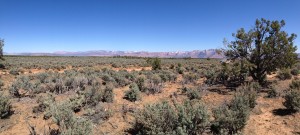
Native plant growth in a “high desert” climate. One can’t destroy what took 5,000 years to create and expect to rectify the damage within a 2-year time frame.
By the same token, developers of construction projects that disturb broad expanses of desert landscape could also benefit from state-of-the-art reclamation technologies. All too often more ground is being disturbed than absolutely needs to be disturbed (Los Angeles County has recently banned clear-grading in the course of constructing solar facilities). Once that disturbance has occurred, we constantly observe outdated tried-and-failed revegetation practices being implemented that have little-to-zero chance of producing sustainable stabilization results. The cost of repeated attempts at stabilizing soil can mount up quickly when outdated and ineffective approaches are being used.
Conventional soil stabilization practices do not even begin to address what we know to be the underlying key challenge to soil stabilization: sustainable native plant growth achieved by re-establishing a functioning soil community in that soil zone where live topsoil once existed.
The Quattro Alliance Solution:
Quattro Environmental and the Quattro Alliance team of professionals have the technologies to mitigate the Mojave Dust Bowl problem. We have demonstrated this repeatedly over 20 years in challenging environments spanning Wyoming, Montana, Idaho, Eastern Washington and Eastern Oregon, down through Nevada and south into the Mojave and Sonoran deserts of California and Arizona.
The drought is a convenient scapegoat for the extreme levels of fugitive dust currently blanketing the Antelope Valley whenever the afternoon winds blow. However, even if the much-hoped for El Nino phenomenon arrives later this year, the above-average rains will not bring sustainable relief to the fugitive dust problems of the “high desert” regions — unless a readily available technology such as Quattro’s Living Soil Membrane® (“LSM”) is brought to bear.
This LSM® technology addresses both the immediate “Holding Soil” challenges of the specific project, as well as the “Growing Soil” challenges to successfully re-establish sustainable native plant growth for long-term soil stabilization. Nurturing early seral stage plant species in tandem with mineral balancing + biological amendments sets the stage for the natural, accelerated re-establishment of a functioning, site-specific soil biological community. Conversely, absent the revival of such a functioning soil biological community (as is the case with conventional reclamation practices), hardy native plant species have little chance of survival.
Utilizing Quattro’s “Holding Soil” technologies NOW to immediately stabilize soil while the “Growing Soil” protocol works on the underlying (literally) factors of healthy native plant ecology will ultimately produce a viable, long-term and enduring solution to the Mojave Dust Bowl problem. By doing so, developers and agency personnel will be able to take advantage of the El Nino rains expected as early as fall 2014.
Footnote*: The Mojave Desert in California (within which the Antelope Valley is located), at elevations of 2,000 to 5,000 feet, is a transition desert between the hot Sonoran Desert to the south, and the cooler Great Basin Desert to the north. The climate has extreme fluctuations of daily temperatures (as low as 8°F in January and as high as 119°F in August). Although it is windy during all months, in late winter and early spring winds in excess of 25 mph with gusts of 75 mph or more are not uncommon.
09 May 2014
Quattro Certified® Reclamation
From time to time Quattro Environmental is asked to guarantee the success of a native revegetation seeding project. On such occasions, I ask the project manager/landowner if they can:
- Guarantee that the weather, rainfall, heat, wind and other forces of nature will cooperate with our efforts;
- Guarantee that the design is appropriate for the site and soil; and
- Guarantee that the products, seed and technology are applied exactly as specified in the design.
If the landowner can guarantee all of that, then I am happy to guarantee the success of the project. So far, no one has agreed to that proposition.
Let’s step back and take a look at what happens all too frequently in our industry. Here’s a typical scenario; you can apply the variations: A design firm is hired to design an erosion control revegetation plan for a project. The project is put out to bid. If it is a state agency, the “low bid” mandate prevails, and the winning bid is so low that we all know the likelihood is high that the specified seed + soil amendment products have not been ordered and will not be used, thus the design will not be implemented. The design firm has no authority over the implementation, thus the low bid contractor is free to use his own tried and true “design.” State agencies all too often lack, or simply don’t use, the muscle to enforce implementation of their approved designs. Is it any wonder that so many native revegetation projects fail?
In another incident just over a decade ago, I listened in wonder as a State agency, frustrated by 100% failure rates in their own roadside revegetation projects, seriously demanded that a seeding contractor guarantee the outcome of their (the State agency’s) reclamation design. Holding a contractor liable for the success of a revegetation effort designed by a third party is unreasonable and counter-productive, and making an applicator the scapegoat for a failed seeding effort makes about as much sense as blaming a house painter for cracks in the foundation.
In the absence of a third party willing to shoulder a project manager’s/land owner’s ultimate responsibility for successful revegetation on disturbed land, the question remains: “Is there any way to guarantee success?”
Quattro’s answer to that question is: “We will certify our results”. What does that mean to the client?
First: All parties involved in the reclamation project understand and agree that the ultimate responsibility for effecting a successful reclamation project remains with the landowner in charge of the property. Responsibility commensurate with authority should be the guiding principle here. Ultimate control and liability rests with the landowner throughout, not with the design firm, seed supplier, contractor or anyone else.
Second: All parties, including the landowner, proceed as a Quattro Alliance team to address both the “Holding soil” and “Growing soil” challenges that must be overcome to successfully re-establish sustainable native plant growth on the subject property. The Quattro Alliance uses a multitude of professional disciplines to address a challenging reclamation undertaking. This team approach is essential to ensuring that we manage all the issues that are critical to successful native revegetation, and then follow through flawlessly with a reasonable plan that maximizes the potential for success. Nature is not against us, nor is she for us. She is a force to be reckoned with that is not within our control. She is also intolerant of any “weak links” in our design + implementation efforts. And as climate change grips the planet, “average” weather conditions become harder and harder to predict. So a reasonable plan of attack makes the best use of finances, resources, logistics, talent — everything that is within our control — to achieve each site’s reclamation objectives under climate conditions that can be reasonably expected for the site, remembering that actual conditions may be far off that mark.
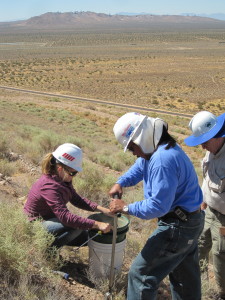
Soil sampling at Borax Mine, CA
Third: Quattro’s next task is to employ the team’s “Best Value” technology approach. The shortcomings of the “low bid” mandate (currently the purview of public agency clients) comes into sharp relief when contrasted with a “Best Value” mandate, more typically found among private clients.
Many erosion control practitioners may remember the well-attended Contractor Forum at the 1997 IECA conference in Nashville, TN, where after 90 minutes of lively discussion we broke up with the somewhat startling consensus that the “low bid” contract invariably turns out to be the most expensive route to implementing a seeding project. Here we are almost 20 years later still grappling with the fallacy of the “low bid” mandate.
Fourth: Quattro’s team, which has designed the “Best Value” approach within the constraints of the project manager/landowner, is authorized to implement the design. Because the design is “Best Value,” there is no need to put it out for bid. Application is an integral factor in Quattro’s Certified® process. This “Best Value” technology approach has proven highly successful over the past 15 years on diverse terrain and climates spanning all states within the western U.S.
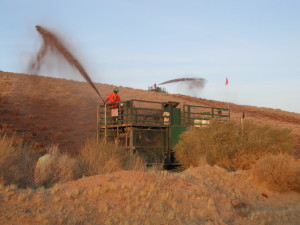
Hydroseeding soil amendments
I mention the constraints of the project manager/landowner because budget is always a constraining factor. The higher the level of certainty desired, the more budget that should be invested. For example, a higher treatment rate of heavy-duty soil binder to withstand a 100-year storm event versus merely a 50-year storm event might be contemplated; or boosting humic substances to ensure one surpasses a minimum threshold that is required to buffer for soil mineral imbalances or salt toxicity in the seedbed soil, or increasing the protein nutrient supplied to expand the window of time during which early seral stage plant growth can be sustained until such time as nutrient cycling is effectively launched. (Resist all temptations to counterproductively double the seed and fertilizer budget!)
Fifth: If included in the budget, the Quattro Alliance team monitors its projects and remains actively engaged in responding to errant acts of Nature, hungry bunnies or whatever other devils beset a project. We keep working until the goals of the revegetation project are met.
This is what Quattro’s Certified® reclamation means. Everything within the control of the Quattro Alliance team, from the start to the finish of the project and beyond, is held to the highest “Best Value” standards. The client can be guaranteed that what he is paying for, he is getting: Quattro’s methodology, team of professionals and proven technologies. A steady stream of consistently successful revegetation projects, now spanning decades, underscores why hiring the Quattro team has paid off handsomely for our clients who are interested in a “Do it once, Do it right” approach.
03 Apr 2013
Quattro Environmental Launches New Website!
It’s taken a little longer than expected, but Quattro is proud to announce the launch of our new website. Be sure to check out our new BIND Series and GROW Series product lines and our sustained performance case studies that profile our proven track record of successful for erosion control and native revegetation projects.



